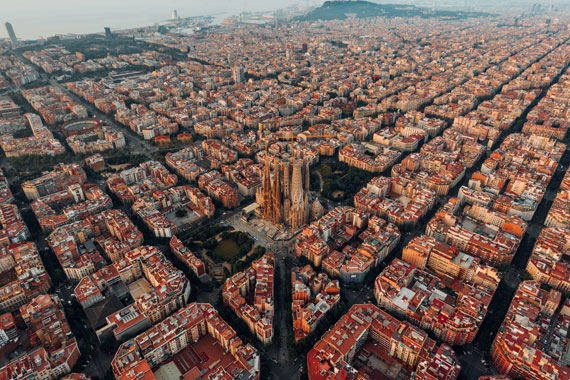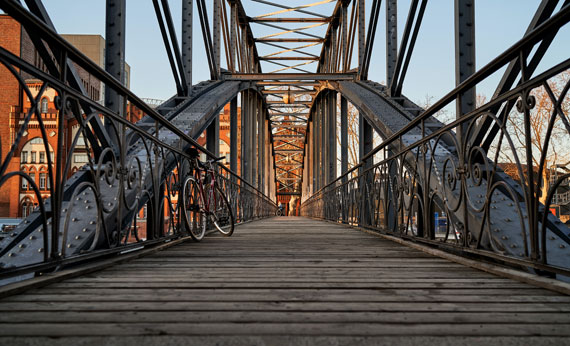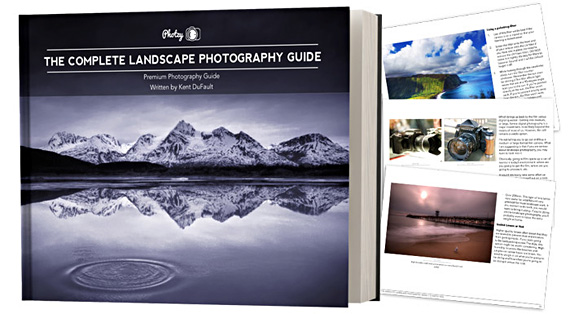Patterns are an important element of photography composition because they add visual interest and rhythm to an image. When used effectively, patterns can create a sense of movement and draw the viewer’s eye around the frame.
Related reminder: only a few days left for the Complete Landscape Guide at 58% Off

Photo captured by dylan nolte; ISO 800, f/2.8, 1/125s.
Capturing patterns within a city can be a fun and rewarding way to photograph the world around us. Here are some tips to help you capture stunning patterns in urban environments:
Look for repeating elements: Patterns are made up of repeated elements, so one of the first things to do when looking for patterns in a city is to scan the scene for anything that repeats. This could be architectural details like windows or balconies, or it could be natural elements like trees or bushes.
Look for contrast: Patterns often stand out more when there is a high level of contrast between the elements that make up the pattern. For example, a row of white buildings against a blue sky can create a strong visual pattern.
Experiment with different compositions: Once you have found a pattern, experiment with different compositions to capture it in the most interesting way. Try framing the pattern with other elements in the scene, or shooting it from different angles to create a unique perspective.
Use leading lines: Leading lines are lines within a scene that draw the eye towards the subject. In the case of using patterns in cityscape photography, you can use leading lines to draw the viewer’s eye towards the repeating elements and help to emphasize the pattern. Leading lines could be a row of trees, a line of buildings, or even a sidewalk.
Pay attention to the light: The way light interacts with the patterns in a scene can greatly affect the final image. Look for patterns that are lit in a way that creates interesting shadows or highlights, as this will add depth and texture to the photograph.
Experiment with composition: Patterns can be photographed from a variety of angles, so don’t be afraid to experiment with different compositions to find the one that works best for the scene. Try shooting from above to create a bird’s-eye view of the pattern, or get close to the ground for a more abstract perspective.

Photo captured by Logan Armstrong
Play with the exposure: Adjusting the exposure settings on your camera can help to bring out the details in a pattern and create a more striking image. Try using a slower shutter speed to blur any moving elements within the scene, or a higher ISO to capture patterns in low light conditions.
Use a wide-angle lens: A wide-angle lens will allow you to capture a larger scene, which can be helpful for showing the repetition of elements within a pattern. This can give your photo a sense of depth and scale, and can help to emphasize the pattern. However a telephoto lens can also work to zoom in on certain scenes.
Here are a few places where you might find interesting patterns within a city:
- Sidewalks and streets: Look for patterns in the arrangement of tiles on sidewalks, or the lines and markings on streets.
- Buildings: The repetition of windows, doors, and other architectural elements can create interesting patterns on the facades of buildings.
- Public spaces: Patterns can be found in the arrangement of benches, planters, and other elements in public squares and parks.
- Transportation: Look for patterns in the arrangement of cars on a busy street, or the repeating shapes of train tracks or subway stations.
- Nature: Even in the midst of a bustling city, you can find patterns in the growth of plants and trees. Look for repeating shapes in the leaves of a tree, or the arrangement of petals on a flower.
These are just a few examples of the many places where you might find interesting patterns within a city. Keep your eyes open and you’re sure to discover many more!

Photo captured by Norbert Braun; ISO 100, f/4.0, 1/80s.
In conclusion, capturing patterns within a city can be a fun and rewarding way to photograph the world around us. Whether you’re looking for repeating elements on the streets, interesting architectural patterns on buildings, or the beauty of nature within the city, there are endless opportunities to find and photograph interesting patterns. So grab your camera, get out there, and start exploring!
For Further Training:
If you are looking for more help with your landscape photography, you may want to check out this in-depth guide while it is currently 58% off. It contains 237 pages jam-packed with training, illustrations, and assignments for photographers seeking to take better landscapes.
It covers everything you need to know to take consistently great landscape shots – lens and gear help, developing your own style, post-processing guides, composition tips, how to get unique images, and much more.
Deal ending soon: The Complete Landscape Photo Guide at 58% Off
Like This Article?
Don't Miss The Next One!
Join over 100,000 photographers of all experience levels who receive our free photography tips and articles to stay current:







Leave a Reply